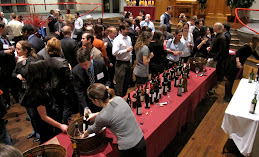I did not blog last week because I was behind the great Chinese firewall, which continues to block blogspot. I returned from China on August 14 after completing a very rewarding field trip with six students from my Vermont Law School summer course in Comparative U.S./China Environmental Law. We visited several environmental groups, government officials, academics and private practitioners interested in environmental law. An album of photos from the trip is now available in the “Photo Albums” section of my parallel website at: http://www.globalenvironmentallaw.com (click the "Photo Albums" link on the top of the opening page).
After arriving in Beijing on the afternoon of August 5 we visited Tiananmen Square and the National Center for Performing Arts and then had a Beijing duck banquet. On August 6 we visited the Temple of Heaven and Qianmen Street before meeting with the All China Environment Federation (ACEF). ACEF is a government-organized non-governmental organization, often referred to as a GONGO. On the day we visited them ACEF had just filed an important lawsuit against China’s National Ocean Administration charging that the agency had illegally allowed oil drilling to resume after the Bohai Bay oil spill. We had a lengthy discussion of the cases ACEF has brought and the controversy over a proposed change to China’s basic Environmental Law that would make them the only organization that could bring public interest environmental lawsuits. Other environmental groups argue that it is unfair only to allow the one environmental GONGO to bring such lawsuits. It is widely anticipated that this provision will be changed before final amendments to the law are adopted. Following our meeting ACEF treated us to a banquet.
On August 7 we visited the Beijing office of the Natural Resources Defense Council (NRDC), the Center for Legal Assistance to Pollution Victims (CLAPV), Greenpeace, and the Regulatory Assistance Project. At NRDC’s Beijing office Qian Jingjing gave us an overview of NRDC’s work in China. NRDC has been working with Chinese NGOs to promote the rule of law and to use information disclosure to encourage greater public participation in regulatory policy decisions. NRDC’s Beijing office is focusing on issues involving energy efficiency, green buildings, and the greening of corporate supply chains. NRDC’s offices are LEED certified, incorporating bamboo in their flooring. For several years NRDC has been working with Chinese NGOs to rate 113 Chinese cities annually on how well they provide environmental information to the pbulic under China”s Open Information Act.
CLAPV, founded in 1999, has just moved into more spacious offices near their former home on the campus of the China University of Political Science and Law (CUPL). CLAPV founder Wang Canfa reported that his environmental ”hotline” has received 13,000 calls resulting in 300 cases being brought. CLAPV also has trained more than 1,000 judges and lawyers in environmental law. Professor Wang recently opened a law firm to bring public interest environmental cases. The firm is called the Beijing Environmental Aid Law Firm, he explained, because the government would not let him use the words “Public Interest” in the firm’s name.
We then met with officials from Greenpeace East Asia, which was started in Hong Kong in 1997 and opened up a Beijing office in 2002. There are 17 full-time staff employed by Greenpeace in Beijing, but because their Beijing office cannot raise funds directly, it is supported largely through donations to its Hong Kong office. Greenpeace’s Beijing office focuses on five issue areas - climate and energy, forests, toxics, food and agriculture, and oceans. It is placing considerable effort into using social media, such as Sina Weibo, a popular microblogging site, to mobilize consumers to pressure companies to abandon environmentally damaging practices. Greenpeace staff also noted that the Chinese government has adopted some of their recommendations concerning toxic chemicals that should be banned.
We then met with Max Dupuy and Wang Xuan at the China office of the Regulatory Assistance Project (RAP). RAP works on energy efficiency issues including how to connect renewable energy projects to China’s State Grid. They noted that the Chinese government has issued directives setting caps on the amount of coal that can been used in the provinces around Beijing. These caps eventually will be reduced to reduce coal consumption and the air pollution it produces.
Also accompanying us on the trip was James Bruen from the San Francisco law firm of Farella Braun & Martel. Jim is the co-chair of the pro bono committee of the American College of Environmental Lawyers (ACOEL). When I was elected to membership in ACOEL last October I recommended to the pro bono committee that they consider providing assistance to Chinese environmental groups. At our meetings with Chinese groups we discussed opportunities for such pro bono representation and received many positive responses. Jim will present a report on our discussions when ACOEL holds its annual meeting in Boston in October.
On Thursday afternoon August 8 we flew from Beijing to Shanghai after visiting the Great Wall at Mutianyu in the morning. At Mutianyu the wall is considerably elevated so we reached it by chairlift. To descend from the wall we slid down on toboggans.
On Friday August 9 we had a very informative meeting with officials from the legal department of the Shanghai Environmental Protection Board (EPB). Shanghai’s EPB is considered one of the best in China. Because China’s regulatory system is so decentralized, EPB’s are vital actors in environmental protection efforts. The Shanghai EPB brings its own enforcement cases and supports 18 districts of the metropolitan area that have their own EPBs. The administrative department of the Shanghai EPB has the power directly to punish violators, but they also focus considerable efforts on helping companies come into compliance voluntarily. The officials described their relationship with the national Ministry of Environmental Protection (MEP) as primarily one of going to MEP seminars that provide them with professional guidance. They welcome greater public involvement in the implementation and enforcement of environmental law and the use of public interest environmental lawsuits. They conceded that the public has not had much influence on decisions by the EPB in the past, but opined that they probably will in the future. We discussed whether there will be more information sharing and cooperation between EPBs in the future. Environmental disclosures are becoming more important and agencies increasingly are using the internet to keep the public informed. They noted that in China government officials can be held liable for negligent supervision of the regulated industry, which can make being an environmental official a “high risk career,” though such liability rarely is imposed.
In the afternoon of August 9 we met with a group of private environmental lawyers at the beautiful new law school building of Shanghai Jiaotong University in the west part of downtown. The meeting was organized by Shanghai Jiatong law professor Zhao Huiyu who hosted our visit to Shanghai and Hangzhou. The lawyers included Li Chen, chair of the environmental committee of the Shanghai Bar Association, and Nora Hu, a former prosecutor who has practiced law for more than 15 years and has obtained an LL.M. from the University of Southern California. They noted that many lawyers in China are interested in environmental law, but that only a few are really able to specialize in it. They predicted that it will take three to five years before a true environmental bar will materialize in China. Because Chinese environmental laws are so poorly enforced, few Chinese companies are concerned about compliance or their reputations for environmental performance, but this is expected to change in the future.
On August 10 & 11 our group participated in an extraordinary conference on efforts to protect the environment in Tibet. The conference on “Conservation, Resource Management and Local Governance in Tibet: Challenges and Prospects in Policy Perspective,” was sponsored by the Tibet Governance and Practice (TGAP) program. It was held at the Harvard Center Shanghai in Pudong. On Saturday I chaired a panel on “Environmental Problems of the Tibetan Plateau: Questions on the Current Situation.” The conference program is available online at: www.tgapforum.org.
On Monday August 12 our group took the bullet train from Shanghai to Hangzhou. In Hangzhou we visited Zhejiang University’s Gaunghua Law School where we met with environmental law faculty. Professor Qian Shuimiao, who has been helping to draft new environmental protection laws for Zhejiang Province, hosted a luncheon for our group. Shanghai and Hangzhou have been gripped by a record heat wave that had yet to abate when we visited. For nearly a month temperatures exceeded 40 degrees C each day, equivalent to 104 degrees Fahrenheit, which had reduced tourism in Hangzhou, a popular vacation site. On August 13 we visited the Lingyin Temple area near Hangzhou, but scaled back our touring plans due to the extreme heat.
This is a particularly pivotal time for China as the country’s new leadership struggles to respond to public protests spawned by horrendous pollution problems that choked the nation last winter. Extreme air pollution was not evident during our visit largely because it rained during part of our time in Beijing, but bright green algae blooms appeared on most bodies of water that we passed. Our meetings with Chinese environmentalists revealed a growing, determined civil society operating in the shadow of concern over what direction the new government will take. One surprisingly ominous development is a directive to universities issued by the Chinese government in May listing “seven forbiddens” - topics not to be discussed in classrooms, including civil society, constitutionalism, freedom of press, human rights, universal values, and administration of justice. While draft amendments to the country’s basic environmental law would open the door to public interest environmental litigation, even ACEF, the one group that it would allow to bring such actions, often finds that its existing cases are not accepted by the courts. The lack of an independent judiciary and a tradition of respect for the rule of law will continue to bedevil efforts to use lawsuits to protect China’s environment, but some environment groups are developing creative new strategies not dependent on litigation.
In 2007 Ecuadoran President Rafael Correa promised that the country would not extract heavy crude oil located beneath Yasuni National Park if the international community would contribute $3.6 billion to compensate for the lost oil. The proposal attracted considerable publicity and small contributions from Spain, the Andean Development Bank, the Inter-American Development Bank, and others. However, with only $13 million collected to date, Correa declared on August 15 that “the world has failed us.” Correa explained that “it was not charity that we sought from the international community, but co-responsibility in the face of climate change.” Ecuador estimated that extraction of the oil and destruction of the rainforest above it could increase greenhouse gas emissions by 1.2 billion tons. Correa stated that he will propose legislation to allow oil exploration in Yasuni, though limited to less than 1% of its area. Brad Plumer, “‘Pay Not to Drill’ Plan in Ecuador Hits Rock,” Washington Post, August 17, 2013, at A12.

















